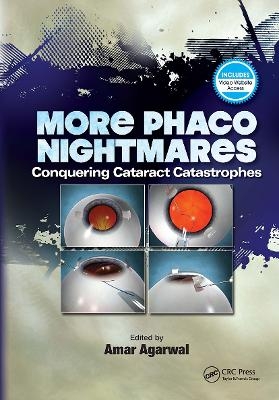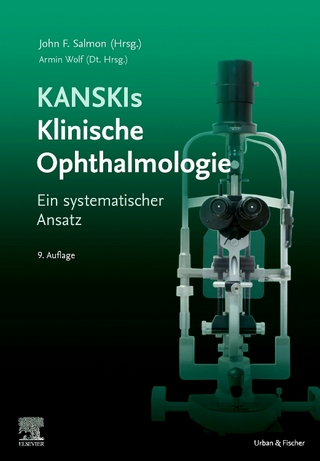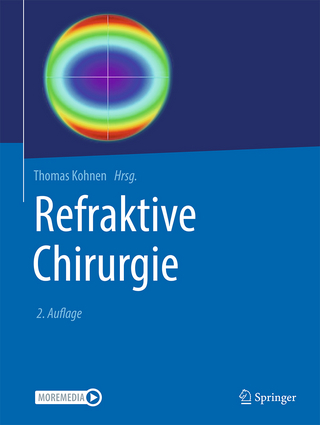
More Phaco Nightmares
SLACK Incorporated (Verlag)
978-1-63091-439-4 (ISBN)
Dr. Amar Agarwal, along with over 35 of today’s cataract surgery leaders, explain all there is to know about phacoemulsification and bring their extensive experience with their own surgical nightmares. The book contains 5 sections that gradually escalate from the basics to nightmares, furnishing phaco surgeons with complicated scenarios and the essential guidance to assess, manage, and resolve.
Featuring updated content and brand new, state-of-the-art chapters on a variety of complex situations, More Phaco Nightmares is the toolkit surgeons need to stay in control when facing unique and especially challenging intra- and postoperative complications.
Sample chapters include:
The Phaco Machine
Air Pump, Gas-Forced Infusion, and Active Fluidics
Intraoperative Floppy Iris Syndrome
Single-Pass Four-Throw Pupilloplasty
Management of Capsule Rupture at Cataract Surgery
Malpositioned Intraocular Lens
Optic Capture
Glued Intraocular Lens
Management and Prevention of Negative Dysphotopsia
Pseudophakic Cystoid Macular Edema
More than 350 illustrations and photographs supplement the text, providing visual as well as textual references for each case. Plus, an accompanying video website contains over 4 hours of new, original, high-quality video content, offering additional visual learning to demonstrate the techniques discussed.
Offering cutting-edge information, More Phaco Nightmares: Conquering Cataract Catastrophes will guide surgeons on how to mitigate the common problems and unanticipated disasters that may arise for even the most experienced surgeons.
Amar Agarwal, MS, FRCS, FRCOphth, is the pioneer of phakonit, which is phaco with needle incision technology. This technique became popularized as bimanual phaco, microincision cataract surgery (MICS), or microphaco. He was the first to remove cataracts through a 0.7-mm tip with the technique called microphakonit. He also discovered no-anesthesia cataract surgery and FAVIT, a new technique to remove dropped nuclei. This technique is now called sleeveless phaco tip–assisted levitation (SPAL). The air pump, which was a simple idea of using a fish aquarium pump to increase the fluid into the eye in bimanual phaco and co-axial phaco, has helped prevent surge. This built the basis of various techniques of forced infusion like active fluidics for small incision cataract surgery. He also discovered a new refractive error called aberropia. He was also the first to do a combined surgery of microphakonit (700-micron cataract surgery) with a 25-gauge vitrectomy in the same patient, thus having the smallest incisions possible for cataract and vitrectomy. He was the first surgeon to implant a new mirror telescopic IOL (Lipshitz macular implant) for patients suffering from age-related macular degeneration. He was the first in the world to implant a glued IOL. In this, a PC-IOL is fixed in an eye without any capsules using fibrin glue. The Malyugin ring for small pupil cataract surgery was also modified by him as the Agarwal modification of the Malyugin ring for miotic pupil cataract surgery with posterior capsular defects. Dr. Agarwal’s Eye Hospital also did the first anterior segment transplantation in a 4-month-old child with anterior staphyloma. Dr. Agarwal has brought out the technique of IOL scaffold, in which a 3-piece IOL is injected into an eye between the iris and the nucleus to prevent the nucleus from falling down in posterior capsule ruptures. He has combined glued IOL and IOL scaffold in cases of posterior capsule rupture where there is no iris or capsular support and termed the technique glued IOL scaffold. Dr. Agarwal’s Eye Hospital also did a glued endocapsular ring in cases of subluxated cataract for the first time. Pre-Descemet’s endothelial keratoplasty (PDEK) was initiated by Dr. Agarwal. In this, the pre-Descemet’s layer and the Descemet’s membrane with endothelium are transplanted en bloc in patients with diseased endothelium. Dr. Agarwal’s Eye Hospital first did contact lens–assisted collagen cross-linking (CACXL), a new technique for cross-linking thin corneas, and they have also worked on E-PDEK, in which an endoilluminator is used to assist in PDEK surgeries. Dr. Agarwal designed the new instrument called the trocar anterior chamber maintainer, now in complicated cases, which helps give infusion through the anterior chamber and works like a trocar cannula. He also started a new technique of iris suturing called single-pass four-throw (SFT) pupilloplasty. This is used for closed-angle glaucoma and for mydriatic cases. He was the principal investigator for the Bausch & Lomb study in the first human eyes using hypersonic vitrectomy with Vitesse. The first 20 surgeries of posterior vitrectomy were done at Dr. Agarwal’s Eye Hospital. He was also the first in the world to use hypersonic vitrectomy with the Vitesse for a case of posterior capsule rupture with nuclear fragments. He did an anterior vitrectomy, posterior vitrectomy, and nuclear fragment removal with the same Vitesse 23-gauge probe. Dr. Agarwal has performed more than 150 live surgeries at various conferences. His videos have won many awards at the film festivals of the American Society of Cataract and Refractive Surgery, American Academy of Ophthalmology, and European Society of Cataract and Refractive Surgeons. He has also written more than 75 books, which have been published in various languages (English, Spanish, and Polish). In his center, he trains doctors from all over the world on phaco, glued IOL, LASIK, and retinal surgeries. He is the chairman and managing director of Dr. Agarwal’s Group of Eye Hospitals, which has 75 eye hospitals across 14 countries all over the world. He can be contacted at dragarwal@vsnl.com. The website of the hospital is http://www.dragarwal.com.
Acknowledgments About the Editor Contributing Authors Preface Foreword Section I Phaco: Machine and Technique Chapter 1 The Fluidics and Physics of Phaco Chapter 2 The Phaco Machine Chapter 3 Air Pump, Gas-Forced Infusion, and Active Fluidics Chapter 4 Preparing for the Transition to Phacoemulsification Section II Difficult Cases Chapter 5 Astigmatism in Cataract Surgery Chapter 6 Pediatric Cataract Surgery Chapter 7 Small Pupil Chapter 8 Intraoperative Floppy Iris Syndrome Chapter 9 Posterior Polar Cataracts Chapter 10 Subluxated Cataract Chapter 11 Phacoemulsification in White Cataract Chapter 12 Iris Reconstruction Chapter 13 Single-Pass Four-Throw Pupilloplasty Chapter 14 Combined Cataract and Glaucoma Surgery Section III Posterior Capsule Rupture: What Next? Chapter 15 Trocar Anterior Chamber Maintainer: An Improvised New Concept of Infusion Chapter 16 Management of Capsule Rupture at Cataract Surgery Chapter 17 Intraocular Lens Scaffold Chapter 18 Dropped Nucleus Chapter 19 Malpositioned Intraocular Lens Chapter 20 Posterior Capsule Rupture and Posterior Polar Cataracts Section IV Intraocular Implantation in Eyes With Deficient Capsules Chapter 21 Optic Capture Chapter 22 Iris Suturing of an Intraocular Lens Chapter 23 Scleral-Fixated Intraocular Lens Chapter 24 Glued Intraocular Lens Chapter 25 Flanged Intrascleral Intraocular Lens Fixation With Double-Needle Technique Section V Miscellaneous Chapter 26 Complications of Femtosecond Laser–Assisted Cataract Surgery Chapter 27 Bullous Keratopathy Managed With Endothelial Keratoplasty Including Pre-Descemet's Endothelial Keratoplasty Chapter 28 Management and Prevention of Negative Dysphotopsia Chapter 29 Pseudophakic Cystoid Macular Edema Chapter 30 Postoperative Endophthalmitis, Toxic Anterior Segment Syndrome, and Other Postoperative Inflammatory Syndromes Chapter 31 Vitrectomy-Assisted Phacoemulsification Financial Disclosures Index
| Erscheinungsdatum | 14.06.2018 |
|---|---|
| Verlagsort | Thorofare |
| Sprache | englisch |
| Maße | 178 x 254 mm |
| Gewicht | 1065 g |
| Themenwelt | Medizin / Pharmazie ► Allgemeines / Lexika |
| Medizin / Pharmazie ► Medizinische Fachgebiete ► Augenheilkunde | |
| ISBN-10 | 1-63091-439-8 / 1630914398 |
| ISBN-13 | 978-1-63091-439-4 / 9781630914394 |
| Zustand | Neuware |
| Haben Sie eine Frage zum Produkt? |
aus dem Bereich


